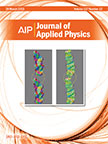 As yet another example of an application where AC field Hall measurements would be useful, we’d like to call attention to this Model 8404 HMS-related research just published in the Journal of Applied Physics. It examines the study of sputtered Yb-filled CoSb3 skutterudite thin films for high-temperature thermoelectric material and provides insights into how heat-treating methods greatly affect Hall mobility.
As yet another example of an application where AC field Hall measurements would be useful, we’d like to call attention to this Model 8404 HMS-related research just published in the Journal of Applied Physics. It examines the study of sputtered Yb-filled CoSb3 skutterudite thin films for high-temperature thermoelectric material and provides insights into how heat-treating methods greatly affect Hall mobility.
As part of this study, researchers affiliated with Stony Brook University, Virginia Tech, Brookhaven National Lab, and Tsinghua University used a Lake Shore Model 8404 Hall measurement system to measure carrier concentration, Hall mobility, and conductivity for 860 nm thin film samples annealed at different temperatures. And based on their findings, this appears to be an excellent application for AC Hall field measurements precisely because of the low mobilities involved—mobilities that would be difficult to measure in a standard DC Hall system.
This is evident in Table III, which shows measurements on a sputtered sample prepared at room temperature (Y1) and three samples with varying heat treatment applied (Y2, Y3, and Y4). You will see that mobilities on the “as sputtered” Y1 sample with no heat treatment applied were rather small—at 0.07 cm2/V s. Even as heat treating is applied (in Y2 and Y3), mobilities did not increase enough to a level where DC field Hall measurements would reliably characterize the mobilities—at least within the margin of error. It is not until heat treatment at 1,020 K (Y3 sample) that you are at a level where mobilities can be measured using DC field Hall with any real confidence.
Something to keep in mind if you are developing material processes: initial attempts at process development will often yield less than optimal results. Characterization tools, like AC field Hall, with a wide range of measurement capabilities, can help you to determine the best way to optimize process development.
